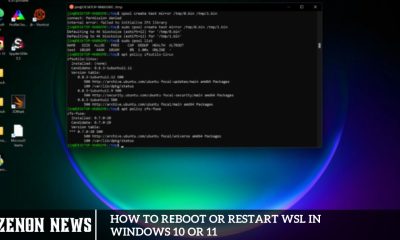News
How to Make Windows 11 Look Like Windows 10 [2024]
![How to Make Windows 11 Look Like Windows 10 [2024]](https://zenonnews.com/wp-content/uploads/2024/05/How-to-Make-Windows-11-Look-Like-Windows-10-2024-1.jpg)
With the introduction of Windows 11, Microsoft ushered in a significant overhaul in its operating system’s visual and fundamental aspects, setting it apart from its predecessors. While the revamped aesthetics may resonate with some users, there remains a sizable contingent who harbor a preference for the familiar interface of Windows 10.
There are both encouraging and discouraging developments for those seeking the versatility of Windows 11 while desiring the aesthetic familiarity of Windows 10. Regrettably, most of the visual alterations implemented in Windows 11 are irreversible, rendering a complete restoration of the Windows 10 style unattainable.
However, amidst these constraints, there exist avenues for personalization that can effectively emulate the Windows 10 aesthetic on a Windows 11 system. In the following discourse, we shall delve into these personalized adjustments to navigate the transition seamlessly.
Transform the Appearance and Experience of Windows 11 to Resemble Windows 10
Although options are constrained, it’s still feasible to imbue your Windows 11 PC with a semblance of the familiar Windows 10 aesthetic through selective adjustments.
These include relocating the start menu and taskbar to the left, integrating a Windows 10 icon pack, and establishing the default wallpaper reminiscent of Windows 10. These alterations collectively emulate the essence of Windows 10, offering a quick visual transformation to your Windows 11 environment.
The subsequent discussion meticulously examines each customization option to facilitate a seamless transition toward a Windows 10-esque ambiance.
Adjusting the Start Menu and Taskbar Placement
Upon powering up a Windows 11 PC, one immediately notices a significant alteration in the user interface: the Start menu and taskbar have been relocated, departing from their customary positioning in Windows 10.
While reminiscent of MacOS aesthetics, this adjustment primarily aims to enhance usability for touchscreen aficionados. To modify the positioning of the Start menu and taskbar in Windows 11, adhere to the following steps:
- Right-click on the toolbar and opt for “Taskbar settings.”
- Navigate to the “Taskbar behaviors” section and expand it.
- Select “Left” from the dropdown menu for Taskbar alignment.
Following these steps will realign the Start menu and taskbar to the left side of the screen. Subsequently, it is advisable to deactivate certain desktop icons specific to Windows 11 to further refine the visual transformation.
Repositioning Taskbar Icons
Windows 11 has shifted the primary taskbar icons from their traditional left alignment to the center of the taskbar. However, rectifying this adjustment is straightforward if it doesn’t suit your preference.
To revert to the previous alignment:
- Right-click on the taskbar and choose “Taskbar Settings” from the menu.
- Within the “Taskbar Behaviors” section, locate the “Taskbar Alignment” option.
- From the dropdown menu, select “Left” to relocate the taskbar icons.
By selecting this setting, the Start button will return to its familiar position in the screen’s bottom-left corner, followed by application icons. As in prior Windows versions, you can customize the taskbar by pinning frequently used applications and accommodating currently active ones. The Taskbar Settings page also enables you to conceal the search bar and other buttons according to your preferences.
Deactivate Newly Added Icons
Certain desktop features like widgets and chat are exclusive to Windows 11 and absent in the Windows 10 user interface. To align your Windows 11 desktop with the appearance of Windows 10, it’s imperative to turn off these icons. Here’s a step-by-step guide to achieve this:
- Press Windows Key+I to access Windows settings.
- Navigate to the “Personalization” option located in the left pane.
- Scroll down and choose “Taskbar.”
- Toggle off the possibilities for Taskview, Widgets, and Chat.
In addition to these adjustments, other icons within Windows 11 have undergone visual enhancements to conform to the operating system’s overall aesthetic. Fortunately, these icons can be substituted with Windows 10’s icon pack. Refer to the subsequent topic for detailed instructions on executing this transition.
Installing Windows 10 Icon Pack
Next, you’ll want to integrate the Windows 10 icon pack into your Windows 11 system. To do so, visit the Winaero website to procure the Windows 10 icon pack file, which will be available in RAR format.
Once downloaded, extract the compressed file and organize the icon files into a designated folder for easy access. Subsequently, press Windows Key+I to access Windows settings and navigate to Themes > Desktop icon settings. From there, click “Change Icon…” followed by “Browse” to locate the icon pack folder.
After completing these steps, you can personalize various Windows elements, such as This PC or the recycle bin, by selecting custom icons. For instance, you can opt for the recycle bin icon from Windows 10 to further refine its visual resemblance to its predecessor.
Chapter 1: Understanding the Transition to Windows 11
This section will explore the key differences between Windows 10 and Windows 11, highlighting the changes in user interface, taskbar layout, and system functionalities. Understanding these differences will provide context for why some users may prefer the familiarity of Windows 10 and seek to replicate its appearance in Windows 11.
Eliminate Recently Added Icons
While we’re on the subject, let’s deactivate the recently added icons introduced by Windows 11. These options can be found in the Taskbar section of the Personalization settings. Within this section, you’ll encounter a list labeled “Taskbar items” containing four entries: Search, Task View, Widgets, and Chat. Utilize the toggles adjacent to each item to turn off all four icons.
An essential clarification regarding Search: There’s no method to restore the full Search field functionality from the Windows 10 taskbar. Turning off the new Search icon means you won’t be able to access Search by clicking on a field or icon in the toolbar. However, it will remain accessible via the Windows + S keyboard shortcut.
Choose a Fresh Desktop Background
Finally, to complete the transformation set the default screensaver of Windows 10 as your wallpaper on your Windows 11 PC. Start by opening a web browser and navigating to google.com. Search for “Windows 10 wallpaper” and choose a high-resolution image from the search results. Right-click on the desired image and select “Save image as.”
Once the download is finished, locate the saved image file in your directory. Right-click on the image file and select “Set as desktop background.” Your desktop will now closely resemble that of Windows 10.
For further customization options, consider utilizing free third-party tools such as Rainmeter or Open-Shell to tailor your desktop experience to your preferences.
Addressing Performance and Stability Concerns
While cosmetic changes can enhance the user experience, potential impacts on system performance and stability must be considered. We’ll discuss best practices for implementing customization tweaks safely, including creating system restore points and using reputable tools to minimize risks.
Frequently Asked Question
Why would someone want to make Windows 11 look like Windows 10?
While Windows 11 offers a sleek and modern interface, some users prefer the familiarity and functionality of Windows 10. Making Windows 11 resemble Windows 10 can provide a more comfortable user experience for those accustomed to the older operating system.
Can I change the Start menu to resemble Windows 10?
Yes, you can. You can use third-party tools or tweaks to modify the Start menu layout, icons, and functionality to closely resemble Windows 10.
How can I get the taskbar to look like Windows 10?
A3: There are several ways to achieve this. You can change the taskbar layout, icons, and position to mimic Windows 10. Third-party customization tools or manual tweaks can help you accomplish this.
Can we revert the window controls (minimize, maximize, close) to the Windows 10 style?
Yes, it is possible. You can use third-party applications or registry edits to customize the appearance and behavior of window controls to match those of Windows 10.
Will changing Windows 11 to look like Windows 10 affect its performance or stability?
A5: Generally, cosmetic changes should not significantly impact performance or stability. However, using reputable tools and following instructions carefully is essential to avoid potential issues. Always create a system restore point before making significant changes.
Are there any downsides to making Windows 11 resemble Windows 10?
A6: While making Windows 11 look like Windows 10 can enhance familiarity, it may also result in missing out on new features and improvements introduced in Windows 11. Additionally, future updates or compatibility issues with third-party customization tools could arise.
Conclusion
While Windows 11 introduces a fresh and modern user interface, some users may prefer the familiarity and functionality of Windows 10. Fortunately, with the help of third-party tools, tweaks, and customization options, it’s possible to make Windows 11 closely resemble Windows 10 in terms of the Start menu, taskbar layout, window controls, and overall appearance.
However, it’s essential to proceed cautiously and use reputable tools to avoid potential performance, stability, or future compatibility issues. Additionally, while reverting Windows 11 to look like Windows 10 can enhance familiarity for some users, it may also mean missing out on new features and improvements introduced in Windows 11.
News
Binary Option Is It Safe? Answer

Introduction
Binary options are a financial instrument that allows traders to bet on the direction of a certain asset’s price movement for a fixed amount of time. Despite their attractiveness because of their simplicity and the possibility of making quick money, they involve high risks.
What are Binary Options?
Binary options (or “digital options”) offer two possible outcomes: the trader either makes a fixed profit or loses his bet. This allows you to know in advance the amount of possible profit and loss. Among the advantages of binary options:
- Trading binary options does not require in-depth knowledge of financial markets or complex strategies. You only need to predict whether the price will be higher or lower than the current price.
- The opportunity to make money in the shortest possible time.
- Binary options often have expiration dates of a few minutes.
- The trader knows how much he or she can lose or make even before making a trade. This helps to manage risk more effectively.
- Many options brokers are ready to offer convenient and functional trading terminals, such as the author’s terminal Pocket Option – a reliable broker that has earned the trust of traders.
Binary Options Risks
Binary options are considered a high-risk instrument because price fluctuations on short time intervals can be unpredictable. In some countries, binary options are almost unregulated, which creates a favorable environment for fraudsters and unscrupulous brokers. Without proper analysis and strategy, trading binary options can become a game of chance, where the outcome of trades depends more on luck than on the trader’s skill.
Scams and Unscrupulous Brokers
Fraud in the binary options industry is common. Often scammers create fake platforms that do not pay out winnings or manipulate prices. Here are a few signs to look out for:
- Hidden terms of bonuses and promotions.
- Broker may delay or refuse to withdraw funds.
- Dishonest brokers may change asset prices in their favor.
- Too many negative reviews about the broker on the web.
Precautions
- Choosing a reliable broker
Check for licensing and regulation. Reliable regulators: FCA (UK), CySEC (Cyprus), ASIC (Australia), etc. Read reviews from real users and check broker ratings on independent platforms.
One of the top and reliable brokers today is Pocket Option, on whose website you can study its license, see its terminal, trading conditions, withdrawal conditions and contact support. All this shows that such a broker can be trusted.
- Training and practice
Take courses on binary options trading. Use the broker’s demo account to practice without the risk of losses.
- Strategy development
Study different trading strategies and choose the one that suits you. Apply technical and fundamental analysis to make informed decisions.
- Risk Control
Determine how much capital you are willing to risk in each trade. Use risk management strategies, such as setting stop losses and take profits.
- Explore the market
Learn the basics of how financial markets work and the different types of assets you can work with. Study the macroeconomic factors that can affect asset prices.
- Be careful with bonuses
Some brokers offer deposit bonuses, but they may come with complicated withdrawal terms. Therefore, read the terms and conditions of bonuses and promotions carefully.
- Keep an eye on the news
Economic events and news can have a significant impact on asset prices. Use economic calendars and keep an eye on major events that can affect your trading.

Conclusion
Binary options offer the opportunity to make quick money, but they also come with high risks. Success in binary options trading requires education, experience and discipline. Choose your broker carefully, continually educate yourself and develop strategies to minimize risk and increase your chances of success. Always remember that investing in financial instruments, including binary options, can lead to losses, so invest responsibly and only invest what you are willing to lose.
News
White Hair and Natural Prevention Methods – Wellhealthorganic.com

Have you started noticing white strands among your once-pigmented hair? You might be wondering what’s causing this change and how to prevent it. Don’t worry; you’re in the right place! Welcome to WellHealthOrganic’s guide on understanding the causes of white hair and exploring natural prevention methods.
Imagine this scenario: you’re preparing for a special event, and a silver strand catches your eye as you glance in the mirror. While some embrace the wisdom that comes with gray hair, others may wish to preserve their youthful appearance a little longer. Regardless of your perspective, we’re here to explore the science behind this change and provide natural, practical strategies to maintain your hair’s vitality.
So, find a comfortable spot, brew a soothing cup of herbal tea, and join us on a journey to uncover the secrets of white hair and discover ways to nurture your locks with care. Your hair deserves the best, and we’re here to guide you every step of the way.
White Hair: WellHealthOrganic.com’s Guide to Causes and Natural Prevention
Imagine having a trusted resource that serves as your guide to navigating the complexities of white hair. That’s precisely what “WellHealthOrganic.com’s Guide to White Hair Causes and Natural Prevention” offers!
This website is your go-to source for understanding why your hair might be turning white and discovering easy, natural methods to prevent it. Think of it as a knowledgeable friend who shares insights on why hair changes color and how to maintain its natural hue without relying on harsh treatments.
Covering everything from the science behind white hair to practical tips for preserving your hair’s youthful appearance, this resource has it all. If you’re curious about those emerging white strands and eager to explore natural remedies, WellHealthOrganic.com is your guide.
The Importance of WellHealthOrganic.com’s Guide to White Hair Causes and Natural Prevention
Understanding why hair turns white and discovering natural prevention methods is essential for maintaining vibrant, healthy locks. Here’s why this knowledge matters:
Preserve Your Youthful Appearance:
By understanding the causes of white hair, you can take proactive measures to extend your youthful appearance. Natural prevention techniques help retain your hair’s original color, keeping you looking and feeling youthful for longer.
Empowerment Through Knowledge:
Knowledge empowers you to make informed decisions about hair care. WellHealthOrganic.com provides the information you need to manage your hair’s health confidently.
Avoid Harmful Chemicals:
Many commercial hair products contain harsh chemicals that can damage your hair. Natural prevention methods help you avoid these substances, protecting your hair and scalp.
Holistic Well-Being:
Hair care is not just about aesthetics; it’s about overall well-being. Natural methods support your health by promoting a balanced lifestyle and enhancing your overall wellness.
Boost Self-Confidence:
Maintaining your natural hair color can significantly enhance your self-esteem. Preventing premature graying through natural methods can boost your confidence and positively impact your self-image.
Sustainable Hair Care:
Natural remedies are often more eco-friendly than conventional products. By choosing natural methods, you reduce your environmental footprint and support sustainable practices.
Long-Term Hair Health:
Natural prevention focuses on nurturing your hair from within. A holistic approach promotes long-term health and vibrancy, ensuring strong and healthy hair for years.
Comprehensive Step-by-Step Guide to Natural Hair Care | WellHealthOrganic.com
Understanding White Hair Causes:
Discover the factors contributing to white hair, such as genetics, aging, and environmental influences. Understand the role of melanin, the pigment responsible for hair color, and how its gradual decline leads to the appearance of white hair.
Assessing Genetic Factors:
Explore how family history and genetics influence the onset and extent of white hair. Consider genetic insights or consult healthcare professionals to assess your risk factors.
Exploring Environmental Influences:
Identify how pollutants, UV rays, and chemical treatments can accelerate graying. Take proactive steps to minimize exposure to these harmful elements and protect your hair from damage.

Embracing Natural Prevention Methods:
Explore natural methods to prevent white hair without relying on harsh chemicals. Embrace a holistic approach with proper nutrition, stress management, and natural hair care routines.
Nourishing Your Body:
Understand how a balanced diet supports healthy hair and can help delay graying. Incorporate antioxidant-rich foods and essential nutrients to maintain hair pigmentation and overall vitality.
Managing Stress:
Recognize how stress affects hair health and contributes to premature graying. Practice relaxation techniques like meditation, yoga, and deep breathing to manage stress and support healthy hair.
Adopting Natural Hair Care Routines:
Implement gentle hair care practices, including regular washing and conditioning. Use natural products free from harsh chemicals to preserve your hair’s color and health.
Incorporating Herbal Remedies:
Explore herbal treatments like henna, amla, and sage to enhance your hair color. Experiment with homemade masks and natural remedies to strengthen and nourish your hair.
Seeking Professional Advice:
Consult a healthcare provider if you experience sudden changes in hair color. Discuss treatment options and receive personalized care tailored to your specific needs.
Extra Tips for Naturally Preventing White Hair
Stay Hydrated: Drink plenty of water to keep your hair and scalp hydrated, preventing dryness that can lead to graying.
Protect from Sun Exposure: Use hats or UV protection to shield your hair from the sun’s harmful rays.
Limit Heat Styling: Reduce heat styling tools to avoid damaging your hair.
Massage Your Scalp: Stimulate blood flow with regular scalp massages to promote healthy hair growth.
Trim Regularly: Regular trims help prevent split ends and keep your hair looking its best.
Use Gentle Accessories: Opt for accessories made from soft materials to avoid hair breakage.
Practice Patience: Natural remedies take time to show results, so be consistent and patient.
Embrace Gray Gracefully: If white hair appears, wear it confidently as a mark of experience and wisdom.
Stay Positive: Focus on maintaining healthy hair and embracing positive changes.

Advantages and Disadvantages of Natural Hair Care
Advantages:
Healthier Hair: Natural methods provide essential nutrients to nourish your hair and scalp.
Sustainable Approach: Eco-friendly practices reduce your environmental impact.
Cost-Effective: Natural remedies are often more affordable than commercial treatments.
Reduced Chemical Exposure: Avoid harsh chemicals to protect your hair’s health.
Holistic Wellness: Support overall health with a balanced lifestyle.
Customizable Solutions: Tailor natural methods to meet your individual needs.
Long-Term Benefits: Maintain your hair’s natural color and vitality over time.
Disadvantages:
Time-Consuming: Requires consistency and patience to see results.
Limited Efficacy: Results can vary based on individual factors.
Lack of Immediate Results: Natural remedies may take longer to show effects.
Need for Consistency: Requires dedication to maintain a routine.
Professional Consultation: Severe cases might need medical advice.
Cultural or Social Pressure: Societal expectations may influence decisions.
Potential Inconvenience: Additional steps and preparation compared to commercial products.
Frequently Asked Questions
What causes white hair?
A: White hair can be caused by various factors, including genetics, aging, stress, and environmental influences. The gradual decrease in melanin, the pigment responsible for hair color, is a primary factor.
Can natural methods prevent white hair?
A: Natural methods can help slow the graying process by nourishing the hair and scalp, but results may vary depending on individual factors such as genetics and overall health.
What are some effective natural remedies for preventing white hair?
A: Effective natural remedies include a balanced diet rich in antioxidants, regular scalp massages, herbal treatments like henna and amla, and a healthy lifestyle to manage stress.
How does diet impact the prevention of white hair?
A: A balanced diet supports hair health by providing essential nutrients for hair pigmentation. Foods rich in antioxidants and vitamins, such as fruits, vegetables, nuts, and seeds, are particularly beneficial.
Are there any specific herbs that can help maintain hair color?
A: Yes, herbs such as henna, amla, sage, and rosemary are known for their properties in enhancing hair color and promoting overall hair health.
How can I protect my hair from environmental damage?
A: Protect your hair from pollutants, UV rays, and harsh chemicals by wearing hats, using UV protection products, and using natural, gentle hair care products. Avoid excessive heat styling and chemical treatments.
What role does stress play in graying hair?
A: Stress can accelerate the graying process by affecting melanin production. Managing stress through relaxation techniques such as meditation, yoga, and deep breathing can help maintain hair color.
Conclusion
White hair is a natural part of aging that can be influenced by genetics, lifestyle, and environmental factors. While the appearance of white strands is often inevitable, understanding the underlying causes and exploring natural prevention methods can help maintain your hair’s health and color for as long as possible.
Adopting a holistic approach, including a balanced diet rich in essential nutrients, regular scalp massages, and herbal treatments like henna and amla, can support hair vitality. Protecting your hair from environmental damage and managing stress through relaxation techniques are crucial steps in this journey.
At WellHealthOrganic.com, we believe in the power of natural remedies and sustainable practices. Choosing gentle, eco-friendly hair care routines protects your hair from harsh chemicals and contributes to a healthier planet.
News
Key Signs of Gastroenteritis – Essential Guide from WellHealthOrganic.com

Gastroenteritis, often called stomach flu, is a common condition characterized by inflammation of the stomach and intestines. It is typically caused by infectious agents such as viruses, bacteria, or parasites, leading to significant discomfort and potential health risks.
Recognizing the critical signs of gastroenteritis, as detailed on WellHealthOrganic.com, is crucial for prompt and effective treatment. This comprehensive guide delves into the primary indicators of gastroenteritis and offers practical advice for managing and preventing the condition.
What is Gastroenteritis?
Gastroenteritis is an inflammation of the stomach lining and intestines, leading to symptoms such as diarrhea, vomiting, and abdominal cramps. It can be caused by infections from viruses (such as norovirus or rotavirus), bacteria (like Salmonella or E. coli), or parasites. Poor hygiene, contaminated food or water, and close contact with infected individuals are common ways the disease spreads.
Signs of Gastroenteritis: Insights from WellHealthOrganic.com
WellHealthOrganic.com: Key Signs of Gastroenteritis is a valuable resource designed to educate readers about the essential aspects of gastroenteritis. The article thoroughly overviews this common condition’s symptoms, causes, and treatment options. It aims to help individuals recognize and manage gastroenteritis effectively, providing insights for early detection and proper care to reduce discomfort and mitigate health risks.
Could you share how you discovered this article? Are you exploring gastroenteritis for personal knowledge or professional purposes?
Why Understanding the Key Signs of Gastroenteritis on WellHealthOrganic.com Matters
Early Detection
Identifying gastroenteritis symptoms early is crucial for prompt treatment. Early detection can help relieve symptoms more quickly, decrease the risk of dehydration, and prevent the spread of infection to others.
Prevention of Transmission
Gastroenteritis can spread quickly, mainly when caused by highly contagious viruses like norovirus and rotavirus. Knowing the signs allows individuals to implement preventive measures, helping to reduce transmission in places such as schools, workplaces, and healthcare settings.
Effective Management
Effective management of gastroenteritis involves more than alleviating symptoms. It includes ensuring proper hydration, following dietary recommendations, and recognizing when to seek medical attention. Adequate management can prevent complications and speed up recovery.
Preventing Complications
If left untreated, gastroenteritis can result in severe dehydration and other complications, especially in vulnerable groups like infants, the elderly, and those with weakened immune systems. Recognizing symptoms and responding appropriately are crucial for preventing severe health problems.
Knowing When to Seek Medical Help
Understanding the severity of symptoms helps guide informed decisions about seeking medical care. While many cases of gastroenteritis resolve on their own, severe or prolonged symptoms may necessitate medical intervention. Being well-informed empowers individuals to seek timely medical attention when necessary.

Step-by-Step Guide to Identifying Key Signs of Gastroenteritis on WellHealthOrganic.com
Recognizing Early Symptoms
Gastroenteritis commonly starts with nausea and vomiting due to stomach irritation. Persistent vomiting can result in dehydration. To manage these symptoms:
- Sip clear fluids, such as water or oral rehydration solutions, to stay hydrated.
- Avoid solid foods until the vomiting has ceased.
- Gradually reintroduce bland foods, like crackers or toast, once vomiting subsides.
Identifying Diarrhea
Diarrhea, marked by frequent loose stools, is a key symptom of gastroenteritis. To prevent dehydration and electrolyte imbalance:
- Drink plenty of fluids to replenish lost electrolytes.
- Avoid dairy, fatty, or spicy foods that can worsen diarrhea.
- Consume small, frequent meals of easily digestible foods.
Managing Abdominal Discomfort
Abdominal pain and cramps, often caused by intestinal inflammation, can be managed by:
- Apply a warm compress to the stomach to ease discomfort.
- Using over-the-counter pain relief, if recommended by a healthcare professional.
- Avoiding trigger foods that may exacerbate the pain.
Addressing Fever
A low-grade fever may occur with gastroenteritis. Manage it by:
- Taking fever-reducing medications as directed.
- Staying hydrated helps regulate body temperature.
- Resting in a comfortable and relaxed environment.
Preventing Dehydration
Dehydration is a significant concern, especially for vulnerable groups. To prevent it:
- Drink oral rehydration solutions or fluids rich in electrolytes.
- Monitor urine output and seek medical help if dehydration symptoms persist.
Seeking Medical Advice
Seek medical attention if symptoms are severe or persistent, if there is blood in vomit or stool, or if the condition affects vulnerable individuals.
Preventive Measures
Prevent gastroenteritis by practicing good hygiene and safe food handling:
- Wash hands thoroughly and handle food safely.
- Cook food thoroughly and avoid consuming undercooked meats.
- Drink clean water from safe sources.
Recovery Essentials
Recover with rest, hydration, and gradual food reintroduction:
- Rest and hydrate regularly.
- Start with bland foods like BRAT diet items (bananas, rice, applesauce, toast).
- Monitor recovery progress and adjust activity levels accordingly.
Managing Symptoms
Manage symptoms of gastroenteritis by:
- Staying hydrated.
- Eating small, easily digestible meals.
- Getting plenty of rest.
- Maintaining good hygiene.
- Monitoring the severity of symptoms.
Infectious Gastroenteritis
Viruses, bacteria, or parasites cause infectious gastroenteritis. Each type of infection occurs when the pathogen is ingested, typically through contaminated food or drink. Here are some common types of infectious gastroenteritis:
Escherichia coli Infection: Often encountered by travelers in areas with poor sanitation, this infection is caused by drinking contaminated water or eating tainted raw fruits and vegetables.
Campylobacter Infection: Found in animal feces and undercooked meat, particularly poultry, this bacterial infection results from consuming contaminated food or water, eating undercooked meat (especially chicken), or failing to wash hands after handling infected animals.
Cryptosporidium Infection: This parasitic infection, which can be contracted from swimming in contaminated pools or through contact with infected animals, spreads when parasites are transferred to food or surfaces by an infected person who hasn’t washed their hands after using the toilet.
Giardiasis: Caused by a parasitic infection of the bowel, giardiasis can be contracted by drinking contaminated water, handling infected animals, or changing the diaper of an infected baby without proper handwashing.
Salmonellosis: This bacterial infection in animal feces is spread by eating contaminated food or handling infected animals. Infected individuals can also spread bacteria to others or surfaces by not washing their hands thoroughly.
Shigellosis: Caused by bacteria in human feces, shigellosis can be transmitted when an infected person contaminates food or surfaces by not washing their hands after using the toilet.
Viral Gastroenteritis: This infection is spread through person-to-person contact, such as touching contaminated hands, feces, or vomit or by consuming contaminated food or water.
Treatment and Management of Gastroenteritis
Managing gastroenteritis involves addressing symptoms and preventing complications. Here’s how you can manage the condition:
Hydration
Drinking plenty of fluids is essential to replace lost fluids and prevent dehydration. Oral rehydration solutions (ORS) are recommended for rehydration.
Rest
Adequate rest helps the body recover from the infection and reduces symptoms.
Diet
Once vomiting subsides, start with bland, easily digestible foods such as toast, rice, and bananas. Avoid spicy, fatty, or dairy-rich foods initially.
Medications
Over-the-counter medications like anti-diarrheal drugs may be used, but it’s essential to consult a healthcare provider before use. Antiemetics may be prescribed for severe vomiting.
Preventing Spread
Practice good hygiene by washing hands thoroughly, especially after using the bathroom and before eating. Disinfect contaminated surfaces and avoid close contact with infected individuals.
Stomach Flu and Children
Children and infants are particularly vulnerable to rapid dehydration. If dehydration occurs, it’s crucial to seek medical attention immediately. Signs of dehydration in young children include:
- Sunken soft spot on the baby’s head
- Sunken eyes
- Dry mouth
- Absence of tears when crying
- Reduced urination or very little urine
- Low alertness and energy (lethargy)
- Increased irritability
Gastroenteritis, mainly when caused by a viral infection, is contagious. Children are more prone to experiencing severe symptoms, so it is essential to keep them home from daycare or school until all symptoms have resolved.
Two oral vaccines, RotaTeq and Rotarix, are available to protect against rotavirus, one of the most common causes of viral gastroenteritis. These vaccines are recommended for children starting at two months of age. Consult your doctor to determine if your child should receive these vaccines.
Before administering any medication to your child, consult with a healthcare provider. Over-the-counter drugs to control vomiting are generally not recommended for children under five years old, and medicines for diarrhea are typically not advised for those under 12 years old (some doctors may recommend avoiding these for individuals under 18).

Pros and Cons of Recognizing Gastroenteritis Symptoms
Advantages:
Early Detection and Treatment: Recognizing symptoms early allows for prompt medical intervention, potentially shortening the duration of the illness and reducing its severity.
Prevention of Complications: Awareness of symptoms enables individuals to take preventive measures, such as staying hydrated and resting, which can help prevent complications like dehydration and electrolyte imbalances.
Effective Management: Understanding symptoms facilitates better self-care, including appropriate dietary adjustments and medication use under medical guidance, to manage symptoms effectively.
Reduced Transmission: Identifying symptoms helps individuals take precautions to prevent spreading the infection, reducing transmission in settings such as schools, workplaces, and healthcare environments.
Empowerment and Preparedness: Knowledge of symptoms empowers individuals to make informed decisions about seeking medical care and managing their health, fostering a sense of preparedness and control over their condition.
Disadvantages:
Self-Diagnosis Risks: Misinterpreting symptoms or relying solely on self-diagnosis without professional confirmation can result in incorrect treatment or delayed medical attention.
Anxiety and Stress: Excessive focus on symptoms or constant monitoring may lead to unnecessary anxiety or stress, especially if symptoms are mild or transient.
Misinformation: Relying on unreliable sources or incomplete information about symptoms can cause misunderstandings and incorrect management approaches.
Varied Presentation: Gastroenteritis symptoms can vary greatly in presentation and severity, making it difficult for individuals to assess their condition without medical expertise.
Compliance Issues: Understanding symptoms does not always ensure proper adherence to treatment or preventive measures, mainly if individuals underestimate the seriousness of their condition or fail to follow medical advice.
Frequently Asked Questions
What are the common symptoms of gastroenteritis?
Common symptoms include nausea, vomiting, diarrhea, abdominal pain or cramps, and sometimes fever. These symptoms result from inflammation of the stomach and intestines.
How can I differentiate gastroenteritis from other stomach illnesses?
A combination of nausea, vomiting, diarrhea, and abdominal cramps typically characterizes Gastroenteritis. Unlike other conditions, it often follows exposure to contaminated food or water. If symptoms are severe or persistent, consult a healthcare professional for a proper diagnosis.
What causes gastroenteritis?
Gastroenteritis is usually caused by infectious agents such as viruses (e.g., norovirus, rotavirus), bacteria (e.g., Salmonella, E. coli), or parasites. It can also result from consuming contaminated food or water.
How is gastroenteritis treated?
Treatment focuses on managing symptoms and preventing dehydration. This includes drinking plenty of fluids, using oral rehydration solutions, resting, and gradually reintroducing bland foods. Over-the-counter medications may help alleviate symptoms, but severe cases may require medical attention.
When should I seek medical attention for gastroenteritis?
Seek medical attention if symptoms are severe or persistent, include blood in vomit or stool, or if you are part of a vulnerable group such as infants, the elderly, or those with weakened immune systems.
How can I prevent gastroenteritis?
Prevent gastroenteritis by practicing good hygiene, such as washing hands thoroughly, handling food safely, cooking food properly, and drinking clean water. Avoid consuming food from unreliable sources.
Can gastroenteritis be contagious?
Yes, gastroenteritis can be highly contagious, mainly when caused by viruses like norovirus and rotavirus. Practicing good hygiene and taking precautions can help prevent the spread of infection.
What are the potential complications of gastroenteritis?
Complications of gastroenteritis may include severe dehydration, electrolyte imbalances, and, in rare cases, more serious infections. It is essential to stay hydrated and seek medical help if symptoms worsen.
How can I manage gastroenteritis symptoms at home?
Manage symptoms by staying hydrated with clear fluids or oral rehydration solutions, resting, avoiding solid foods until vomiting subsides, and gradually reintroducing bland foods. Monitor your symptoms and consult a healthcare provider if needed.
What should I do if symptoms do not improve?
If symptoms do not improve or worsen over time, or if you experience severe symptoms like prolonged vomiting, diarrhea, or signs of dehydration, seek medical advice for further evaluation and treatment.
Conclusion
critical signs of gastroenteritis are crucial for effectively managing and preventing this common condition. By recognizing symptoms such as nausea, vomiting, diarrhea, and abdominal pain early, individuals can seek timely medical intervention, prevent complications, and reduce the risk of transmission to others. This essential guide from WellHealthOrganic.com provides valuable insights into identifying symptoms, managing them appropriately, and taking preventive measures. Staying informed and proactive empowers individuals to handle gastroenteritis more effectively, ensuring a quicker recovery and minimizing the impact on their overall health. Always consult a healthcare professional to ensure proper care and treatment for persistent or severe symptoms.
-
![Fix Keyboard Not Working in Windows 10 [Tested Methods]](https://zenonnews.com/wp-content/uploads/2024/05/Fix-Keyboard-Not-Working-in-Windows-10-Tested-Methods-400x240.jpg)
![Fix Keyboard Not Working in Windows 10 [Tested Methods]](https://zenonnews.com/wp-content/uploads/2024/05/Fix-Keyboard-Not-Working-in-Windows-10-Tested-Methods-80x80.jpg) Windows5 months ago
Windows5 months agoFix Keyboard Not Working in Windows 10 [Tested Methods]
-

 Windows6 months ago
Windows6 months agoHow to Type pi π symbol on Windows, iOS and Android
-

 How To6 months ago
How To6 months agoHow to Uninstall Software Update On Android
-

 Social Media6 months ago
Social Media6 months agoHow to Use Facebook Marketplace Without an Account
-

 Windows6 months ago
Windows6 months agoHow to Rеboot or Restart WSL in Windows 10 or 11
-

 How To6 months ago
How To6 months agoHow to Activate USB Debugging on Android Devices
-

 Windows6 months ago
Windows6 months agoHow to Unlock Dell Laptop Keyboard on Windows 10/11
-

 Apps5 months ago
Apps5 months agoYouTube Premium Apk v19.18.34 (Premium Unlocked, No Ads, Many More)












